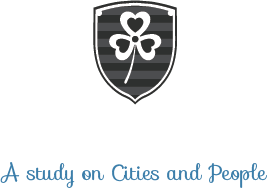Where are people?
The Active City Center
In this entry i’ll try to figure out where people generally spend time in the active city center of a medium sized European city.
Conclusion
Observation
The life in a city can be grouped into different “spots”. A spot is simply a place where people spend time, be it a street, a plaza or a specific corner in a plaza. It’s hard to define what a spot is, so that they are comparable between cities. In order to reach some sort of comparability, I’ve chosen to define a spot based street segments. A street segment is primarily defined by four conditions:
- A space between two intersections
- A street is interrupted by a spatial change, like a street emptying out into a plaza
- A street that breaks with a sharp turn will be divided up in two segments
- A street that is “too long” will divided be up in segments

Furthermore, all spots are not equal. In some spots there might be hundreds of people spending time, whilst in other spots there are none. I’ve chosen to categorize these spots in six categories depending on how active they are. The categories are derived from the median amount of people along with the standard deviation throughout all studied cities. The six categories that are used for outdoor restaurant sitters are as follows:
- Solo spot: 1 person
- Tiny spot: 2-4 people
- Minor spot: 5-19 people
- Medium spot: 20-49
- High spot: 50-99
- Very high spot: more than 100
Since there are always more people spending time in outdoor restaurant seating (private places) than in public places, therefore another lower scale is used for public place sitters:
- Solo spot: 1 person
- Tiny spot: 2-4 people
- Minor spot: 5-7 people
- Medium spot: 8-19 people
- High spot: 20-34 people
- Very high spot: more than 35 people
I will also consider what type of spots we’re working with, not just when it comes to activity, but when it comes to the landscape quality of the spot. By this I mean whether the spot is a street, a plaza or a waterfront. One can make up hundreds of these spot qualities, but in order to keep it manageable I’ve settled on using 7 such qualities:

Ingolstadt

Deventer

Ingolstadt

Amersfoort

Deventer

Bonn

Würzburg
The ‘wide street’ classification came about due to how streets opens up to become more wider streets with more available space for amenities. The sense of direction that a street possesses are still there but so is also the inviting effect of a plaza.
By using the above tools we just created we can answer the question at hand: Where do people spend time in the active city center?
For each of the 19 cities under investigation I’ve created maps that show the distribution of how many people spend time in each spot in the city. The maps for all cities will be shown at the very bottom of the page. In this entry I will make use of the Swedish city of Örebro as my primary example.
People in outdoor restaurant seating
in the active city center of Örebro

15:00-16:30 o’clock

17:30-19:00 o’clock

20:00-21:30 o’clock
The bigger the blob, the more people in each spot. If you zoom into the image you can also see that each blob has the exact amount of people tagged to it. If we are to compare the three time intervals in the maps above we can figure out when each spot is being occupied, and how intensively it is occupied. If we were to apply the 6 categories I introduced earlier, in order to better understand the intensity of usage for each spot, we’ll get a result that looks like this:

The image to the left shows the amount of people divided up between the three time intervals. Each color represent 1 of the 6 spots intensities, yellow being Very High and black being Low spots. The amount of people spending time outside is low at first, and then stabilize around 17:30.
The image in the center shows the percentage distribution of people per spot and interval. Even though the amount of people outside is stable between the two last intervals, the Very high spots are gaining more attraction.
This image to the right shows the amount of active spots between the different intervals. Roughly the same amount of total spots are active throughout the day (22-26 spots), but the Huge spots increases while the lesser spots decreases or stays the same.
These three thematic patterns that we can make with Örebro as an example, is a similar pattern we can see when we bundle together the results of all the studied 19 cities:

The total amount of people increase and stabilizes at 17:30.
The Very high spots increases in representation as the day progresses.
The number of Very high spots increases while the lesser spots decreases or stays the same. However, the amount of spots are roughly the same (ca 30-31).
People in public places
in the active city center of Örebro



15:00-16:30 o’clock
17:30-19:00 o’clock
20:00-21:30 o’clock
Much like the previous set of three maps showing the amount of people spending time in private places – the above three maps shows the amount of people spending time in public places. Yet again we can compare the three time intervals and apply the 6 categories I introduced earlier in order to better understand the intensity of usage for each spot in Örebro, we’ll get a result that looks like this:

The amount of people in public places seem the be stable throughout the three intervals.
In the case of Örebro the largers spots become more inhabited and gets more representation than the smaller spots the later the day.
There is some variation in number of active spots between the intervals (21-26 spots), but it’s nothing that really stands out, much like with outdoor restaurant spots.
By comparing the result of Örebro with the average of all 19 studied cities, we’ll receive a healthy lesson in how generalization is not so easy when it comes to cities:

The amount of people in public places decreases during the later hours of the day. While in the case of Örebro, the amount was stable.
The pattern of Very high spots being more active during the later hours of the day found in Örebro is shifted, and instead the lesser spots are taking a bigger share of the people during the later hours.
Instead of a quite stable amount of spots throughout the day, like we saw in Örebro, instead we see a steady decline of the amount of active spots from 24 down to 16 spots.
Maybe we can better understand the differences between cities, and why they differ from the average, by making use of the landscape qualities that we introduced earlier. In my study a spot can have one of 7 landscape quality: Street, Plaza, Waterfront, Canal, Park, Bridge, Wide Street. Let’s keep using Örebro as an example:




In the above comparisons we can see an interesting trend that can help us understand the discrepancy between the activity of public places in Örebro as compared to the public place activity in all 19 cities. As with Örebro, we can see that the waterfronts are becoming more active for the public places the more the day progresses. However, this is only true for the cities that do actually have waterfronts. Let’s isolate these 5 waterfront cities (Koblenz and Odense not included):

In the image above, we can see that waterfront spots either retains their activity or increase their activity as the day progress. Although a small sample, this would lead me to assume that cities with developed waterfronts has a natural advantage when it comes to public life.
As for the other landscape qualities there is a general pattern that can be found. For private places, Plazas are the most intensely used places being occupied by about 45% of all people outside. Plazas are followed by Streets (35%), Waterfronts (4%), Wide street (3%), Canal (3%), Park (2%) and Bridge (1%). Wide street are special in one sense; few cities have these,but the ones that do tend to be very active, thus misrepresented in this compounded data. If you’re interested in the data for each city you’d have to contact me.

For public places, Plazas are the most active spots for most cities, being occupied by about 39% of the active city centers public life. They are followed by Streets which houses about 18% of the public life, followed by Waterfronts (14%, varies a lot throughout the day and depends on access), Park (13%), Bridge (8%), Canal (2%) , Wide street (2%). Plazas evidently plays a very important role in the public life of cities. The bridge landscape quality deserves further explanation. It is interesting as Würzburg is one of few cities that do sport a bridge landscape quality (Jönköping and Amersfoort are other examples). However, Würzburg’s Old Main Bridge is so active and leaves such an impact on the general data that it bumps up its share to a great extent. The public life on this bridge is certainly a worthy object to observe and definitely my most memorable space! If we compare the usage of public and private places, streets and waterfronts are the ones that changes to a large degree between the two. If you’re interested in the data for each city you’d have to contact me.

So, now we know more about how active the spots are throughout the day and we know more about general landscape qualities of spots. The last question i’m able to address with my data is that of spot distribution; in other words, how many spots is a medium sized city predicted to have, and how intense are they?
I will use the unstudied city of Nijmegen in order to try to predict its spot distribution. We’re still dealing with the 6 types of spot intensities that we introduced earlier, from Solo to Very high spots. Since we have data on spot distribution from my actual observations, we can find the average distribution in the graph below.

By making use of my earlier observations here we can predict how many people should be spending time outside in the city of Nijmegen. Since Nijmegen has a population of about 170 600, we can predict that roughly 802 people will spend time outside in private places and 273 people will spend time outside in public places during the interval 17:30-19:00. Now, with the help of google maps to guess where the most active spots could be, we can apply our prediction on Nijmegens public life to the graphs above and produce the following map of Nijmegen:

That was all for this post. Don’t hesitate to contact me if you want more information or if my explanations are hard to follow, at [email protected].
All Data
Aalborg
Outdoor stationary activities



Amersfoort
Outdoor stationary activities



Bolzano
Outdoor stationary activities



Deventer
Outdoor stationary activities



Enschede
Outdoor stationary activities



Helsingborg
Outdoor stationary activities



Ingolstadt
Outdoor stationary activities


Innsbrück
Outdoor stationary activities



Jönköping
Outdoor stationary activities



Koblenz
Outdoor stationary activities



Linköping
Outdoor stationary activities



Lund
Outdoor stationary activities



Norrköping
Outdoor stationary activities



Odense
Outdoor stationary activities



Osnabrück
Outdoor stationary activities



Uppsala
Outdoor stationary activities



Västerås
Outdoor stationary activities




